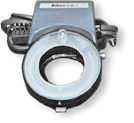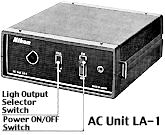".. There's not much else to say. If you're a fan of flat, featureless lighting, or have a burning need for a ringlight, you could probably do better than an SR-1. More modern units will provide TTL flash metering, which is a godsend for close-up photography. On the other hand, if you want to assemble the complete SB-1 system ...". - Michael Liu -
Note: The Nikon Handle mount flash SB-1 featured earlier can also be used to power the SR-1 Ringlight or the SM-1 Ringlight.
Nikon
SR-2/SM-2 Macro Ringlight
Useful accessory:-
Nikon original
Flash couplers for various flash models foot
incompatibility
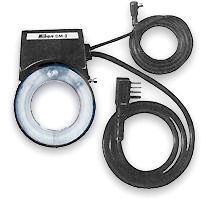 |
 |
The Nikon SR-2
screws into the 52mm filter threads of 35mm to 200mm Nikkor lenses, and operates
down to 20cm for close-up work. It also can be used for general photography. You
can mount the flash on the forward end of the lens.
|
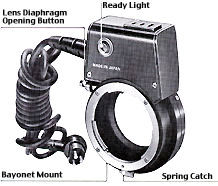 |
 |
The ringlights
use either an AC power supply, LA-1, which can be switched to operate from 100VAC,
117VAC, 220VAC or 240VAC, or even with a battery pack (LD-1). These power supplies
can also be shared and used with the Medical Nikkor lens.
|
Note: In extreme close up range,
normal Guide Numbers are not applicable. You may use an accompanying chart to calculate proper exposures (Vertical scale
is distance in "mm", horizontal values are in f-stop).
 |
Ringlight SR-2
: Designed for use with Nikkor lenses ranging from 35mm to 200mm, this unit screws
into 52mm filter threads on the front of the lens. The ring light connects to its
power source with one cable and to the camera-body sync terminal with a sync cord.
It has a guide number of 48 feet with ASA 100 film when set for FULL power. A switch
on the unit selects 1/4 power and a guide number of 24 feet.
Ringlight SM-2
: Used for macro and close-up photography, this unit provides shadow less illumination
of subjects very close to the lens. Nikon SM-2 is designed for reproduction ratios
of 1:1 (life-size) or greater, mounts directly to the bayonet mount of Nikkor lenses
mounted in the reverse position on a bellows. Although the output light is similar
in amount to the SR-2, no guide number is furnished for this unit because guide numbers
do not accurately predict illumination at extremely short distances. Exposure is
found by consulting charts and tables supplied with the unit.
|
SM-2 bayonets onto
the rear of a reverse-mounted Nikkor lens for macro photography of subjects down to a 12:1 ratio (when the
Nikkor 20mm f/4 or 20mm f3.5 is mounted in the reverse position on the Nikon bellows),
plus it contains its own focusing lamp.
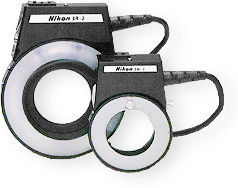 |
The SM-2 contains a built-in
incandescent focusing light. The push button switch that turns on the focusing light
also opens lens aperture wide open, if stopped down. These ringlights provide a solution
to optical-electronic flash combination close-up or macro photography. Both units
can be powered by the Nikon LD-1 (DC power pack) or LA-1 (AC power pack) at full
or in 1/4 light output.
However, these units are not TTL flash as with the SB-21A/B, if you want to take
full advantage and happen to shoot a lot of flash pictures, you may want to consider
getting an SLR that has TTL flash capabilities and invest into the SB-21 setup for
more rewarding and less hassle photography.
|
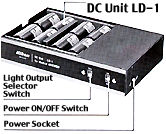 |
" .... Visually, the SM-2 appears nearly identical to its
predecessor, the SM-1. The main differences are that the SM-2 has sockets instead
of the SM-1's permanently attached power and sync cords. The sockets on the SM-2
are similar to other Nikon speedlites.There is the three-prong sync socket and a
half-moon three-pin power socket identical to the one on the later version of the
Medical-Nikkor 200 (not wholly unexpected, as they share the same power supplies
...) Although I am not completely sure, the specs and usage for the SM-2 should be
the same as those for the SM-1
|
Flash exposure control:
Automatic control is NOT
Possible
Manual control: manual at full output and/or 1/4 power;
Guide number (ISO 100, m): NOT
ratable at
macro distance;
Recycling time: manual Approx. 12 sec.
Number of flashes: Approx. 600 at full output and 1200 at 1/4 power (Alkaline
batteries); unlimited (LA-1)…
Angle of Coverage: sufficient for macro coverage
Power source: DC Unit LD-1, AC-Unit LA-1(Can be shared with 200mm f/5.6 Medical
Nikkor lens); LA-1 AC unit
Ready Light: Built-in
Open flash button: Built-in
Modelling Lamp: provided; button-activated
Synch Socket for Eyepiece Pilot Lamp: provided
Ready-light Contact for F2 Series Camera Finders: provided
with accessory SC-4
Mounting: Bayonets onto rear of Nikkor Lens.
Dimensions: Approx. 70mm (W) x 100mm (H) x 35 mm (D)
Weight: Approx. 185g
(6.5 oz)
Accessories: DC Unit LD-1;
AC Unit LA-1; ready-light adaptor SC-4; sync
cord SC-5; coiled sync cord SC-6; sync
cord SC-7; extension cord SE-2; eyepiece
pilot lamp SF-1
More info and specification
on SR-2 by
clicking
here or proceed to SB-18 and SB-19
by clicking "Next" button below.
